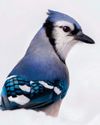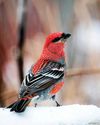Intentar ORO - Gratis
Using Their Senses
Birds & Bloom
|October/November 2018
Discover the fascinating ways birds survivethrough sight, sound, taste, touch and smell.

FINCHES, SPARROWS AND CARDINALS are happily filling up at your backyard feeders. All of a sudden, they quickly fly away, diving into the bushes. Less than a minute later, a hawk swoops through the yard. How did the songbirds know the hawk was coming? Did they smell, or maybe hear, it? To figure this out, it helps to know more about the senses that birds use to experience the world around them.

Bird’s-Eye View
The term “eagle-eyed” for sharp vision is no accident. Nearly all birds see at least two or three times as much detail as humans, making them able to spot food— or approaching predators—that much farther away. Most birds have excellent color vision, too. Night birds like owls may have a biological trade-off: They see very well in dim light, but their perception of colors may not be as good.
Another advantage birds have is seeing ultraviolet light. To humans, male and female northern mockingbirds look exactly the same—but birds are able to tell the difference because the two have different ultraviolet markings.
Esta historia es de la edición October/November 2018 de Birds & Bloom.
Suscríbete a Magzter GOLD para acceder a miles de historias premium seleccionadas y a más de 9000 revistas y periódicos.
¿Ya eres suscriptor? Iniciar sesión
MÁS HISTORIAS DE Birds & Bloom

Birds & Blooms
Ready to Fly
For birders, spring migration is something to look forward to and be celebrated, but how do birds know when it's time to begin their travels?
2 mins
December 2025 / January 2026

Birds & Blooms
COOL AS A Camellia
When temperatures drop, most plants wait out the chilly months, but camellias put on a show. Discover how to have these beauties thriving in your yard.
2 mins
December 2025 / January 2026

Birds & Blooms
Festive Feathers
Readers braved the winter chill to capture these snowy snapshots of the season's most beautiful birds
2 mins
December 2025 / January 2026

Birds & Blooms
Winter Gems
With raspberry-red feathers, pine grosbeaks cheer up chilly landscapes wherever they land
2 mins
December 2025 / January 2026

Birds & Blooms
the mysterious lives of NIGHTHAWKS
These creatures of contradiction aren't hawks and aren't the most active at night, but they are worth knowing
3 mins
December 2025 / January 2026

Birds & Blooms
Adventure Awaits
Pack your bags, get on board and find your next vacation destination in these captivating photos from far-flung travels
2 mins
December 2025 / January 2026

Birds & Blooms
It's All in the Needles
Get to know the greenery to identify these conifers
1 min
December 2025 / January 2026

Birds & Blooms
Christmas Tree Do's and Don'ts
These pro tips will help you get the most out of this classic holiday fixture
2 mins
December 2025 / January 2026

Birds & Blooms
Trailing Houseplants
Simple, easy-to-grow plants for hanging containers
3 mins
December 2025 / January 2026

Birds & Blooms
Better Off with Bats
Rethink the unsung heroes of the night and why you should support them
2 mins
October / November 2025
Translate
Change font size
